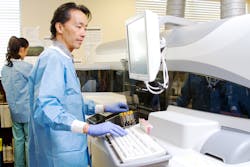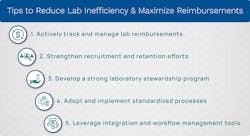Five tips to cut lab inefficiencies, not lab revenue
While there are always ongoing changes within the healthcare industry, the combined challenges that today’s laboratories face are momentous. The transition to value-based care, industry consolidation, declining reimbursements, and workforce shortages are shaping the laboratory landscape. On the plus side, myriad advances in technology are improving test methodologies and providing tools that make it possible for laboratories to reduce inefficiencies and maximize reimbursements. The most successful laboratories adapt to change by leveraging as many tools as possible to sustain their businesses and their contribution to patient care.
Current state of lab reimbursements
One of the most significant legislative acts to impact the laboratory industry is the Protecting Access to Medicare Act of 2014 (PAMA), which resulted in significant changes to the Medicare clinical laboratory fee schedule (CLFS) and created a challenge for laboratories that are required to report their data. Some anticipate that the flaws discovered in the PAMA legislation will possibly be corrected by the pending Saving Access to Laboratory Services Act (SALSA).
Reimbursements decline under PAMA
Under PAMA, the CLFS reimbursement rates are based on the median average laboratories are paid by private payors. Applicable laboratories are required by the Centers for Medicare & Medicaid Services (CMS) to report their private payor reimbursements, which are used to calculate the CLFS. PAMA’s initial cuts resulted in payment reductions for approximately 75% of the most commonly ordered laboratory tests.
Current CLFS rates are based on data from the 2016 collection period that were reported to CMS in 2017. The first PAMA cuts to the CLFS were 10% each year for 2018, 2019, and 2020. The three years of annual cuts culminated in a nearly $4 billion decline in laboratory reimbursements for Medicare beneficiaries.1 In response to the COVID-19 pandemic, the Coronavirus Aid, Relief, and Economic Security Act (CARES) temporarily delayed further PAMA cuts, so there was no payment reduction in 2021. PAMA currently caps pending reimbursement cuts between 2022 and 2024 at 15%.
SALSA swoops in to reform reimbursement policy
In June of 2022, new bipartisan legislation, SALSA, was introduced in both the House and Senate with the intent to modify and improve the PAMA rule. If passed, SALSA will result in significant changes to the PAMA law, such as freezing cuts for 2023, lowering the annual cap rates, postponing the data reporting period, and extending the reporting cycle. If the bill is not passed, more than 800 tests on the CLFS will be subject to 15% cuts as of January 2023.2
Shortage of qualified medical laboratory scientists
In addition to reimbursement controversy, the laboratory industry faces a continuing decline in the number of qualified medical laboratory scientists (MLSs). According to the Bureau of Labor Statistics (BLS), an estimated 329,200 MLSs and technicians were employed in the United States in 2021. The BLS predicts the need for a 7% average increase in this career between 2021 and 2031.3
Declining MLS schools
Despite the need for more qualified MLSs, the number of schools continues to decline, not keeping up with the demand for new scientists as the older generation retires. Since 2000, there has been a 7% decrease in the number of MLS programs with only about 240 programs currently in the United States.4 Consequently, the industry is experiencing an increase in noncertified individuals performing low- to high-complexity tests and an increase of laboratory staff taking on more responsibilities. Some laboratories resort to hiring employees with bachelor’s degrees in biology or chemistry and training them on the job. This situation can negatively impact the overall quality of laboratory services and remains a potential threat to patient safety.
Proposed CLIA amendments on personnel requirements
Additionally, CMS has proposed a rule that would amend the Clinical Laboratory Improvement Amendments (CLIA) to allow nurses to perform moderate- and high-complexity lab testing and those with professional doctorates or a master’s equivalency to serve as high-complexity lab directors. For Certificate of Compliance (COC) labs, CMS is also proposing a 20% increase in CLIA survey fees.5Finding ways to be more efficient
Many laboratories are facing these challenges by finding ways to maximize reimbursements and improve their efficiency and value to their organizations. Laboratories that realize the specific pressures they face can actively plan to focus efforts on activities that increase productivity and efficiency. These efforts include building staff retention and satisfaction, promoting greater laboratory stewardship, and leveraging the technology and tools at hand to improve workflow processes. Below and listed in Figure 1 are tips to help laboratories reduce inefficiencies and maximize reimbursements.
1. Focus on strong recruitment and retention
Staff turnover not only costs the organization, but also results in lost knowledge and time spent training new employees. Top laboratories are finding innovative ways to recruit and retain staff. Offering competitive salaries and benefits, sign-on bonuses, opportunities for career advancement, continuing education, and tuition reimbursement helps to attract new employees.
2. Develop a laboratory stewardship program
Laboratory stewardship means the laboratory takes responsibility for lab testing, from order placement through interpretation and analytics. Highly efficient laboratories are implementing laboratory stewardship programs that allow them to take control of the laboratory process from start to finish. Laboratory stewardship moves beyond tracking laboratory utilization and lab formularies to ensuring that the best tests are ordered and properly interpreted with awareness of the downstream healthcare processes related to lab testing.
3. Achieve consistency with standardized processes
Uniform test methodologies and procedures are a part of laboratory stewardship and decrease the burden of training employees. Standardizing laboratory practices using evidence-based guidelines can improve efficiency, patient satisfaction, quality of care, and overall clinical operations.6 Patients benefit from consistency in laboratory testing, and differences in testing methodologies can be confusing, potentially leading to misinterpreted results. When testing policies, procedures, and methodologies are standardized, manageability, quality, and efficiency improve due to decreased redundancy and errors. In addition, electronic health record (EHR) and laboratory information system (LIS) setup becomes uniform across locations, reducing opportunities for misinterpretation.
For point-of-care or decentralized testing, which is expected to continue growing, it becomes even more important to standardize products and processes to help ensure that all team members are following the same processes and that every facility is conducting testing in an accurate, efficient, and patient-minded manner.
4. Drive effective revenue cycle management
Laboratories are increasingly perceived as cost centers that provide a service, rather than as profit centers. With effective revenue cycle management (RCM), laboratories can ensure that reimbursements are maximized especially for outreach testing, which can be quite lucrative. Claim denials for improper documentation (incorrect CPT code or missing information, for example) and small balances left uncollected can add up to significant amounts. Because the laboratory is a high-volume, low-cost service, ensuring optimal collections is important even for small balances. By having RCM software integrated with the LIS, labs can ensure that collections are effective and automatic. The LIS and/or RCM software can enable rules that improve revenue capture, such as alerts for insurance incompatibilities and prior authorization requirements, automation of CPT code updates to align with testing, and billing problem reports.
5. Leverage integration and tools to automate workflow management
Efficient laboratory workflows require RCM, instrument, LIS, and EHR integration for the automatic flow of data. This integration improves patient care by reducing errors, saving time, and speeding result delivery.
A powerful tool, the laboratory’s LIS can greatly improve laboratory productivity, efficiency, and safety. By careful configuration of analyzer and EHR interfaces, specific rules, tracking features, and automated reporting and metrics, the LIS makes lab professionals’ jobs easier, allowing their expertise to be focused on tasks that require human interaction. Most LISs include audit trails and sample tracking features that provide laboratories with tools to organize and track laboratory samples. Automating these processes improves patient safety and helps laboratories be inspection ready.
Staying on top of industry changes
Today’s healthcare climate requires diligence and attention to outward forces that impact the lab. With looming reimbursement cuts and an ongoing shortage of qualified individuals, laboratories must have efficient billing procedures, effective workflow processes, and the ability to leverage available technology and tools to boost efficiency.
REFERENCES
- AACC. AACC joins other stakeholders in support of the Saving Access to Laboratory Services Act (SALSA). Aacc.org. Accessed September 27, 2022. www.aacc.org/advocacy-and-outreach/comment-letters/2022/clc-provider-salsa-act.
- Klipp J. New bill would delay & reduce Medicare CLFS cuts. Laboratory Economics. 2022;17(7). July 2022.
- U.S. Bureau of Labor Statistics. Clinical laboratory technologists and technicians. Bls.gov. Published September 8, 2022. Accessed September 27, 2022. http://www.bls.gov/ooh/healthcare/clinical-laboratory-technologists-and-technicians.htm.
- ASCP. The medical laboratory personnel shortage (policy number 04-04). Accessed September 27, 2022. www.ascp.org/content/docs/default-source/policy-statements/ascp-pdft-pp-med-lab-personnel-short.pdf?sfvrsn=2.
- Klipp J. Are nurses qualified to perform high-complexity testing? Laboratory Economics. 2022;17(9). September 2022.
- Yu E. Lab standardization in the era of big healthcare networks. Aacc.org. Accessed September 27, 2022. www.aacc.org/publications/cln/articles/2017/september/lab-standardization-in-the-era-of-big-healthcare-networks.
About the Author

Kim Futrell, MT (ASCP), MSHI
is the Products Marketing Manager at Orchard Software. Prior to joining Orchard in 2012, Futrell, who has a Master of Science in health informatics, worked as a lab manager for more than 20 years.

